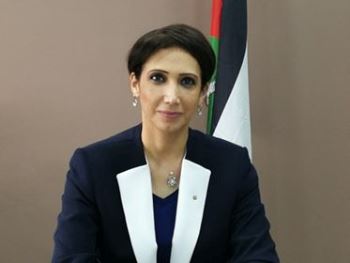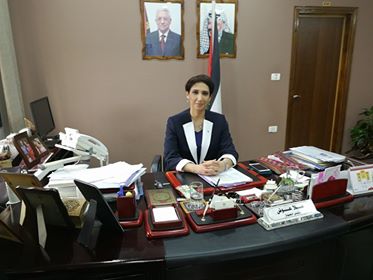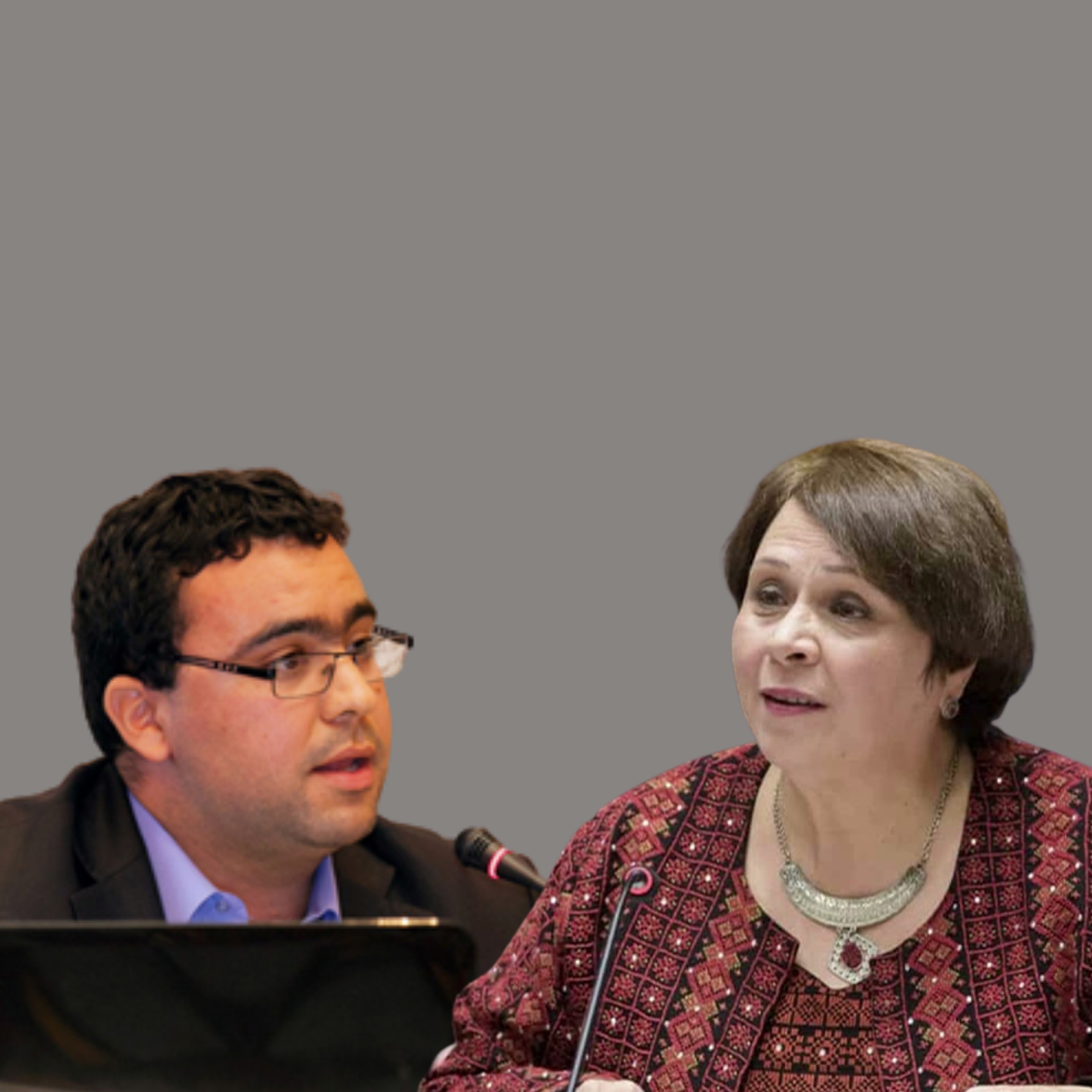
Introduction
Palestinian Central Bureau of Statistics (PCBS) President Ola Awad confirmed that the results of the latest population, housing and facilities census, which were recently released, are an indicator of the quantum leap achieved by the Bureau towards e- data and linking this to geographic information systems, in spite of the challenges they faced.
In an interview with “Hosted by MIFTAH” Awad warned of the increasing unemployment among youths and graduates, in the Gaza Strip in particular, confirming it was time to reach integrative roles between public sector institutions among themselves first, and their role with private sector and civil society institutions, second. She said there needs to be more in-depth analytical studies behind the numbers so that the correct interventions could be carried out. The census results were of interest among the Israelis, who utilized the demographic aspects in their inter-party conflicts to formulate their policies towards the Palestinians.
In regards to the census of Palestinian refugees in Lebanon, conducted by the PCBS, Awad stressed on its importance given that it provides a database of comprehensive and up-to-date statistics on the demographic, economic, social and living conditions of refugees in Palestinian camps and communities within Lebanon. This, she said, will comprise the basic information for formulating plans and strategies and for developing programs and interventions which in turn could improve the living conditions of refugees and provide them with means of a dignified life.
Furthermore, this project provided approximately 1,000 temporary job opportunities for youths for the duration of the various stages of the project.

Following is the full interview:
**What is the methodology adopted by PCBS used in the lasts population census? What is your opinion on the Israeli campaign aimed at casting doubt around it?
Israeli occupation authorities have and continue to doubt any findings issued by the PCBS, especially since we did not have such a bureau in the past. Previously, the Israeli army’s civil administration was the party that gathered information about the Palestinians. However, when the PCBS was established at the end of 1993, the Palestinian statistics establishment and system entered a new and expansive process of development. Even though we are considered a relatively new statistics institution in comparison with other institutions in the Arab region and the world, it is still the most developed. This did not happen in a vacuum; part of this is because of the makeup of Palestinian society, which is considered a young and educated society. Over the years of establishment of the Bureau, we introduced programs to develop human resource and technical capabilities and we now have expertise with which we support many Arab countries in the region.
The PCBS has adopted several international and quality criteria for statistics. There are several developed countries that have not yet reached these criteria. We have reached a level which does not allow anyone to doubt our data and when there are international standards, we work according to them. There are standards of statistical quality and international evaluations we receive from external sources, including the United Nations, which were applied to the most recent census. The fact that the census was implemented according to international standards means there is no room for skepticism regarding its credibility, even though we are aware that the occupation will not like the census results and will try to undermine them.
**What are the biggest challenges you faced during the census, especially in occupied Jerusalem, the old city of Hebron and the areas adjacent to the wall and settlements, and how did you overcome these challenges?
There were challenges on the ground, especially since we are talking about an occupied country. However, with the determination of our data-collection team, we were able to overcome all of the difficulties and challenges resulting in a comprehensive census of about five million people. At the same time, we were conducting periodic surveys and activities in the field in addition to a number of operation rooms we set up, whether for following up on the quality of the collected data or to monitor the field work and all other related aspects which helped us to carry out this statistics process. It took us three years until we were able to announce our census results.
**Some have said there is a lack of comprehensiveness in the statistical process in that it does not include all sectors in some regions
In regards to this point, the percentage of this lack in comprehensiveness was 17% and was in Jerusalem; this is due to the exclusivity of the place and the obstacles our teams faced which sometimes even resulted in their arrest. However, the findings were accepted by the UN’s Statistical Commission. The lack of comprehensiveness in West Bank and Gaza Strip districts, meanwhile, did not exceed 2%.
In all stages of the census, we brought in evaluation teams. In this census we took a major step towards electronic data and linking it with geographic information systems in spite of the challenges we faced, one of which was not having a 3G system. Another obstacle was not always having clear reception service in several areas, including camps and overcrowded areas. Hence, there were many technical challenges over and above the reality imposed on us because of the occupation.
**How can the quality of the data and information in the census be corroborated?
You can confirm the quality of this data in several ways; the first is through the international evaluation teams sent by the UN statistical commission in New York and UNESCWA. These missions evaluated all the technical stages according to each stage. Second is that the data on which the census was based fully aligns with our survey results. Our estimations for 2017 were that the population would reach 5 million people and sure enough, the results were very close to this. The actual number was 4.8 million. This means the quality of our data is very high, which also increases our confidence in our work.
***Did the census give future indicators as to what the population reality will be in the Gaza Strip in the next 10 years, for example, especially in light of reports warning of a population explosion there?
We reflect the reality on the ground, then after the census we work on what are called population projections. The census gave us data indicating that the Gaza Strip population had reached 1.9 million people and that its population density is the third highest in the world. When the number exceeds 5,500 people per square kilometer, this is accompanied by high unemployment rates and difficult social conditions that could reach the point of a humanitarian disaster, which is dangerous in and of itself. If we are talking about the demographic aspect, the fertility rate has dropped in the Strip. While it used to be an average of seven children per woman during her fertile years, this has gone down to five children. There are a number of reasons for this drop, one being the increase in education rates among women, indicating that intervention programs in this regard have made an impact and helped women reach the point where they are not just for reproduction. However, in spite of the decrease in fertility rates in Gaza, it is still high.
**What are the most significant indicators from the census? Are there any negative ones in return?
There are many aspects we can point to when speaking about the census, which reflects the reality and the positive aspects that were developed in comparison to the 1997 census. Among the most positive indictors is that our illiteracy rate is one of the lowest in the Arab region, only behind Qatar, with an illiteracy rate of only 3%. This is considered one of the lowest worldwide.
There is also the early marriage indicator among females. This rate dropped from 31% in the 1997 census to 11% in 2017, which is an important development that can be attributed to all of the programs and interventions that have taken place and have exerted so much effort to bringing down the rate of early marriages.
Another positive indicator is the increase in the levels of education and academic achievement in terms of mid-level diplomas and upwards. This rate was even higher in the Gaza Strip than in the West Bank and higher among females than males. This shows the brighter side of Palestinian society, which is that education still means a lot to men and women and it is an important part of our culture.
Nonetheless, we faced challenges in more than one aspect. The first is the high unemployment rate in Palestine, which has reached 27% and is concentrated in the Gaza Strip, where is reaches 43%. In the West Bank, it is 18%. This is where we see such a discrepancy between the two regions, which is one of the main problems we face. It should be noted that unemployment is higher among youths and university graduates, with unemployment rates among graduates from the various disciplines reaching over 50%.
In my opinion, I don’t think this is the problem of our local universities or of the Ministry of Education and Higher Education. It is all our problem and all parties involved, both the private and public sectors and civil society institutions. This leads us to the question of what are our needs and plans. We must ask ourselves an important question, which is: Where are our investments going? We are talking about Palestine whose economy is a service-based one. Around 60% of its activities are social services; this sector cannot comprehend a large work force. What does comprehend it are the productive social activities suchhas industry, tourism and agriculture. If we look at the census we can see that the contribution of the agricultural sector has dropped to 3% from 13%. However, the production requirements of the agricultural sector have risen go 71%. Based on this, we now have a deficit in the contribution of this sector in the gross domestic product (GDP). Even though it dropped to 3% the amount of production in 1994 was not as much as today.
As for the industry sector, it used to comprise 24%, while today it does not exceed 12%. This is why it is extremely important that investments are focused on the projection sectors, with the knowledge that the tourism sector’s contribution oscillated over past years between 2.5% to 3% of the GDP even though this is the Holy Land and tourism is very important to it.
**What is your opinion on the participation of youth, both male and female, in the production sector? Were there any findings in the census in this regard?
Our labor market is comprised of approximately 900,000 workers while the number of unemployed is estimated at 86,000 workers in the West Bank and 210,000 in the Gaza Strip. However, most of the workers are in the services sector rather than the production sectors. This is because the lower the contributions, the less these sectors need labor. We do not have industries here and the agriculture sector is not in operation, which has of course lowered the number of workers in this sector and therefore lowered wages as well. For example, the average wage in the agriculture sector is NIS50/day as opposed to NIS95 or NIS96 as a day wage in general, thus creating a huge gap in our economic activities.
**To what extent does this impact the participation of youth in the economic construction process in society?
When a person is unemployed, whether male or female, and has no role in the economy of the country or in achieving any economic growth, this leads to severe frustration. That is why not all youths are in the labor market; some are just frustrated with the job search and anyone who is not actively looking for a job can never get into the labor market even if they have the ability to work, which means this does not count as participation in the labor market. For someone to be part of this, they must have the ability and willingness to work and to look for a job by any means. Anyone who does not meet these conditions is outside the labor market, pushing the unemployment rates even higher.
**How can the positive indicators be employed in the service of public policies?
There is a saying that goes: “Anything you cannot measure, you cannot implement”. Hence, the basis of any planning and any policy is data and the basis on which priorities are decided – whether they have an impact or not. That is why data is the infrastructure for us to formulate policies, plans and strategies, carry them out and then measure them. This is the goal of our censuses and of those all over the world.
**How much do the government and the public and private sectors and civil society institutions benefit from the findings and statistics of the census for interventions with enacted public policies?
I was very pleased as the head of this institution that the government gave ample attention to our census results and that President Mahmoud Abbas and Prime Minister Rami Hamdallah participated in the census announcement. This is an achievement in and of itself and it shows how important the census really is; it is not just a health project but it is a national project and one form of sovereignty on the ground.
I recently met with the Council of Ministers during which we discussed the most important results of the census. We agreed on more meetings with ministerial committees and that draft recommendations will be put forth in light of the outcomes of these committees’ work so that we can agree on what the next steps should be by the government. I think the fact that our results were taken seriously from the beginning is very positive and gets us off to a good start. We also hope interest in them will continue, which is largely our role at the PCBS. We all need to work together to achieve progress on the ground. We have a policy agenda and sectoral strategic plans, eventually working up to an integrative plan that includes all sectors and civil society institutions capable of developing our society and economy.
What I would like to say that is, until now, our experience so far as a bureau of statistics has shown an absence of an integrative action plan; that is, each sector has worked alone. Hence, it is time we reach this integration in roles between public sector institutions with each other first and then their role with private sector and civil society institutions.
**Did the census take into consideration the phenomenon of labor in settlements, especially among women? How did it address this issue?
Yes, it did. The census addressed the work and workplaces of respondents, including women. It showed we have a total of 126,000 laborers working inside Israel and in its West Bank settlements, including 18,000 workers in the agricultural sector in these settlements.
**What about the Palestinian countryside? Did the census address the changes to these areas in light of the continuous buildup of settlements and move from this countryside to city centers? What about the PA’s neglect of Area C?
When we talk about Area C, we are talking about around 60% of the area of our land, which is 23 square kilometers in total, in addition to the communities adjacent to the separation wall and settlements and military outposts. In total, this comprises 85% of the area of Palestine within the 1967 borders. Hence, there is only 15% of this area remaining for us in city centers and these are the only operational and active areas in our country. Therefore, I do not say the responsibility only lies with the PA. According to the census results, the onus also lies with the private sector and civil society institutions. Meanwhile, Gaza’s countryside has been permanently erased; there are only camps there.
As for the West Bank, the countryside has shrunk in favor of urbanization. This is why we see internal migration between the northern and southern districts to the central districts, especially to Ramallah, Al Bireh and Beituniya. Even within the district there is internal migration from the countryside to the city. This is attributed to a dysfunction in geographic distribution in addition to the various basic activities. The main reason for this migration is basically to find a means of living.
**Do we need a more in-depth analysis for the latest census? Who will conduct it?
We definitely do. The census is the first step, but what comes after it is what’s important. That is why there needs to be in-depth analyses and studies for many of the indicators. The role of the bureau is to produce metadata that describes the reality, not to produce in-depth studies. That is the role of institutions in the public and private sectors and in civil society institutions, research centers and local universities. This is the more important step so that interventions can be carried out based on solid ground.
**Don’t you think the Israelis will be the first to conduct such analytical studies to use in their formulation of policies towards the Palestinians?
Since we announced the census results, we have seen the nature and scope of the rivalry between the various Israeli political parties. There are some which are skeptical of our numbers and others that confirm them. However, in the end, the rivalry and disputes between them is not to our advantage. They are all looking for how these results reflect on them. Hence, they look at our data from the perspective of how it will serve their vision and goals. Here I should mention that the population growth rate plays an important role in terms of women’s fertility, which is high among us, in spite of its recent drop. For them, the rate of immigration from abroad is 27,000 immigrants a year. If this number remains steady, this could change many projections. But if our current population growth rate stays the same, this means that in a few short years, the number of Palestinians in historic Palestine will be higher than the number of Israelis.
**What were the census results for refugees in Lebanon, which was conducted for the first time ever?
This census was important by all standards; it gauged the amount of suffering and the harsh socio-economic conditions under which Palestinian refugees live in Lebanon and was also conducted because of a lack of accurate statistics reflecting their reality. Also, there is the huge discrepancy in estimations of their numbers among the various official and nonofficial institutions. For the state of Palestine, implementing this project is a qualitative achievement. It is the first general census of Palestinian refugees in Lebanon and will provide a comprehensive and up-to-date database on the demographic, economic, social and living conditions of Palestinian refugees in camps and communities in Lebanon. This will constitute the main factor in drawing up plans and strategies and developing programs and interventions aimed at improving the lives of refugees. From another aspect, this project created around 1,000 temporary job opportunities for youths throughout the duration of its various stages.
We repeatedly stressed that the main goal of the census was to provide accurate data on refugees, far removed from other considerations, so that decision-makers can take the appropriate interventions. The census is to the benefit of every individual and family in these camps and communities and its data will comprise a main component for demanding refugee rights and offering the international community an accurate picture of their suffering. It will showcase the impacts of Israeli occupation policies on them and on all of our people everywhere.
Several important issues were brought to the fore in this census that must be addressed, particularly expanding the scope of jobs and professions Palestinian refugees are allowed to do; allowing Palestinian refugees to build and expand within the camps; granting refugees ownership rights in Lebanon; and improving educational conditions and academic achievement among refugees at the various levels.
The results were given considerable attention from the governments of both countries and we hope the relevant ministries and parties will follow up on these results and assess them with the aim of improving the lives of refugees in Lebanon.









